Today Current Affairs: 2nd June 2022 for UPSC IAS exams, State PSC exams, SSC CGL, State SSC, RRB, Railways, Banking Exam & IBPS, etc
Table of Contents
UN-Habitat Plan For Jaipur:

The UN-Habitat has identified issues associated with Jaipur city like multi hazard vulnerabilities, weak mobility and Green-Blue economy and has laid out a plan to increase sustainability in the city.
- The urban problems which persist in Jaipur are the same for other cities.
- UN-Habitat has based its findings on sustainable cities integrated approach pilot project and a “sustainable urban planning and management” component was implemented in partnership with the Jaipur Development Authority and Jaipur Greater Municipal Corporation.
- The project has received funding from the Global Environment Facility (GEF-6) to estimate the carbon sequestration potential of Indian cities.
Findings of the Project:
- Jaipur got an overall sustainability rating of three on the Urban Sustainability Assessment Framework (USAF) based on the information collected for 87 of its 131 parameters.
- The Urban Sustainability Assessment Framework (USAF) developed under the Sustainable Cities Integrated Approach Pilot (SCIAP) project, implemented by United Nations Industrial Development Organization (UNIDO) and UN-Habitat.
- The UN-Habitat highlighted the following problems which are faced by the city:
- Weak access to a public transportation system, with less number of buses and poor route delineation.
- Extreme levels of drought during summer and also urban floods.
- Lack green cover which has resulted in the urban heat island effect that has disrupted biodiversity.
UN-Habitat
- The United Nations Human Settlements Programme is the United Nations programme for human settlements and sustainable urban development.
- It was established in 1978 as an outcome of the First UN Conference on Human Settlements and Sustainable Urban Development (Habitat I) held in Vancouver, Canada, in 1976.
- UN-Habitat maintains its headquarters at the United Nations Office at Nairobi, Kenya.
- It is mandated by the United Nations General Assembly to promote socially and environmentally sustainable towns and cities with the goal of providing adequate shelter for all.
- It is a member of the United Nations Development Group. The mandate of UN-Habitat derives from the Habitat Agenda, adopted by the United Nations Conference on Human Settlements (Habitat II) in Istanbul, Turkey, in 1996.
- The twin goals of the Habitat Agenda are:
- Adequate shelter for all
- The development of sustainable human settlements in an urbanizing world
NTPC’s Biodiversity Policy:
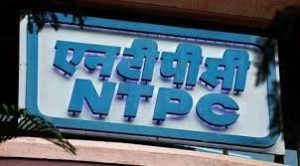
NTPC Ltd, India’s largest integrated energy producer has issued renewed Biodiversity Policy 2022 to establish a comprehensive vision and guiding principle for conservation, restoration, and enhancement of biodiversity.
- This Biodiversity Policy is an integral part of NTPC’s Environmental Policy.
- NTPC was the first PSU to issue Biodiversity Policy in 2018. In the same year, NTPC became a member of the India Business & Biodiversity Initiative (IBBI).
- The power major aims to mainstream the concept of biodiversity across NTPC’s value chain.
- The company will further strengthen its current efforts to achieve a ’no net loss’ of biodiversity at all of its currently operating sites.
- NTPC has also signed a five-year agreement with Andhra Pradesh Forest Department for conservation of Olive Ridley Turtles in the coastline of Andhra Pradesh.
Bharat Drone Mahotsav 2022:
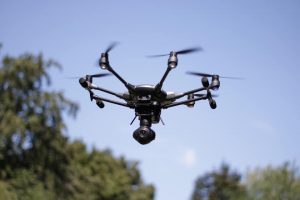
India’s biggest Drone Festival – Bharat Drone Mahotsav 2022 was inaugurated in New Delhi by the Prime Minister.
- A virtual award of drone pilot certificates, panel discussions, product launches, display of a ‘Made in India’ Drone Taxi prototype, flying demonstrations, among others were the key events.
- Drone is a layman terminology for Unmanned Aircraft (UA).
- Originally developed for the military and aerospace industries, drones have found their way into the mainstream because of the enhanced levels of safety and efficiency they bring.
- A drone’s autonomy level can range from remotely piloted (a human controls its movements) to advanced autonomy, which means that it relies on a system of sensors and LIDAR detectors to calculate its movement.
Applications of Drone Technology:
- Agriculture: In the agriculture sector, micronutrients can be spread with the help of drones.
It can also be used for performing surveys for identifying the challenges faced by the farmers. - Defence: Drone system can be used as a symmetric weapon against terrorist attacks.
Drones can be integrated into the national airspace system.
Deployment of drones for combat, communication in remote areas, counter-drone solutions can be done. - Healthcare Delivery Purposes: Indian Council of Medical Research (ICMR) devised Drone-Based Vaccine Delivery Model, i-drone. Telangana and North-east states have been approved to use this drone technology for delivering vaccines in remote areas.
- Monitoring: The drone technology in the SVAMITVA scheme launched by the Government of India, within less than a year, has helped about half a million village residents to get their property cards by mapping out the densely-populated areas.
Drones can be used for real-time surveillance of assets and transmission lines, theft prevention, visual inspection/maintenance, construction planning and management, etc .They can be used for anti-poaching actions, monitoring of forests and wildlife, pollution assessment, and evidence gathering. - Law Enforcement: Drones are also significant for the law enforcement agencies, the fire and emergency services wherever human intervention is not safe and the healthcare services.
Cheetah Relocation In India:

India will be soon releasing cheetahs from South Africa and Namibia into the wild at Kuno Palpur in Sheopur district of Madhya Pradesh.
- It will initiate India’s ambitious plan of transcontinental relocation of cheetahs.
- The country’s last spotted cheetah died in Chhattisgarh in 1947 and it was declared extinct in the country in 1952.
- The Wildlife Institute of India (WII) some years back prepared a cheetah reintroduction project.
- The cheetah is one of the oldest of the big cat species, with ancestors that can be traced back more than five million years to the Miocene era.
- The cheetah is also the world’s fastest land mammal that lives in Africa and Asia.
African Cheetah:
- Scientific Name: Acinonyx Jubatus
- Characteristics: They have slightly brownish and golden skin which is thicker than the Asiatic Cheetahs.
- They have much more prominent spots and lines on their face as compared to their Asian cousins.
- Distribution: Found all over the African continent in thousands of numbers.
- Protection:
- IUCN Red List: Vulnerable.
- CITES: Appendix 1.
- WPA: Schedule-2.
Asiatic Cheetah:
- Scientific Name: Acinonyx Jubatus Venaticus
- Characteristic: Slightly smaller than the African Cheetahs.
- They have pale yellowish fawn coloured skin with more fur under their body, specifically on the belly.Inserting image…
- Distribution: Found only in Iran with less than 100 individuals left.
- Protection:
- IUCN Red List: critically endangered.
- CITES: Appendix 1.
- WPA: Schedule-2.
World Milk Day:

June 1 is observed as World Milk Day every year.
- World Milk Day is a day established by the Food and Agriculture Organization (FAO) of the United Nations in 2001 to recognize the importance of milk as a global food.
- The day is intended to provide an opportunity to bring attention to activities that are connected with the dairy sector.
- This year’s theme will highlight the work already being done to accelerate climate action and help reduce the dairy sector’s impact on the planet.
- Using the World Milk Day platform, awareness of the messaging and action will be raised towards Dairy Net Zero.
India’s Textiles Exports In FY 2021-22:

India scaled its highest ever exports tally at US$ 44.4 Bn in Textiles and Apparel (T&A) including Handicrafts in FY 2021-22, indicating a substantial increase of 41% and 26% over corresponding figures in FY 2020-21 and FY 2019-20, respectively.
- USA was the top export destination accounting for 27% share, followed by EU (18%), Bangladesh (12%) and UAE (6%).
- In terms of product categories, the export of cotton Textiles was US$ 17.2 Bn with 39% share registering a growth of 54% and 67% during 2021-22 over FY 2020-21 and FY 2019-20, respectively.
- Export of Ready-Made Garments was US$ 16 Bn with 36% share showing a growth of 31% and 3% during 2021-22 over FY 2020-21 and FY 2019-20, respectively.
- Man-made textiles export was US$ 6.3 Bn with 14% share which shows a growth of 51% and 18% during 2021-22 over FY 2020-21 and FY 2019-20, respectively.
- Export of Handicrafts was US$ 2.1 Bn with 5% share reporting a growth of 22% and 16% during 2021-22 over FY 2020-21 and FY 2019-20 respectively.
Shimla Garib Kalyan Sammelan:

The ‘Garib Kalyan Sammelan’ in Shima, Himachal Pradesh was addressed by PM Narendra Modi. This programme was organized to mark the completion of eight years of the Narendra Modi-led government.
- It has been organized across the nation at District Headquarters, State Capitals, and Krishi Vigyan Kendras.
- The Sammelan has been organized so that the elected public representatives from across India directly interact with the public to get their feedback regarding the various welfare programmes that are being run by the central government.
- On this occasion, the PM also interacted with various beneficiaries of PM-KISAN from across the nation.
- PM Modi also released the 11th instalment of financial benefits that are given by the central government under the Pradhan Mantri Kisan Samman Nidhi (PM-KISAN) scheme.
- Under the 11th instalment, an amount of around Rs. 21,000 crores will be distributed to over 10 crore beneficiary farmer families across the country.
National Education Ministers Conference:
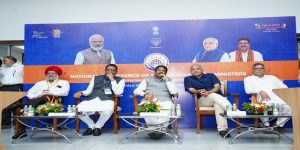
The two-day National Education Ministers’ Conference began on 1st June 2022 in Gujarat. The focus of the conference will be the implementation of the new National Education Policy (NEP).
- This conference is being attended by Dharmendra Pradhan, the Union Education Minister of India as well as other education ministers of various states and union territories across the country.
- This conference has been organised by the Human Resource Development department in Gandhinagar in collaboration with the Ministry of Gujarat.
- The ministers also visited the Bhaskaracharya National Institute for Space Applications and Geo-informatics (BISAG), the Vidya Samiksha Kendra (VSK), the International Automobile Centre of Excellence (iACE), and the National Forensic Science University (NFSU).
- The aim of this two-day conference is to focus on strengthening the country’s education ecosystem.
- The conference also focuses on implementing the National Education Policy 2020, skilling in various schools of the nation, and digital initiatives such as the National Educational Technology Forum (NETF), National Digital Education Architecture (NDEAR), etc.
- The conference also aims to leverage technology to minimise the non-academic work of teachers, strengthen the base of numeracy and literacy, and ensure holistic evaluation of teachers, students, and schools so as to cultivate a vibrant learning and teaching environment.
India’s Gross Domestic Product (GDP) Growth Slowed:
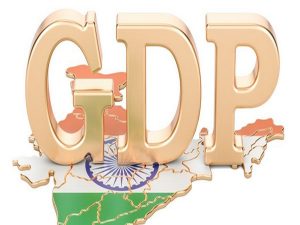
India’s gross domestic product (GDP) growth slowed to a four-quarter low of 4.1% during the January-March period, from 5.4% in the preceding quarter, as manufacturing output shrank, provisional national income estimates show.
- As a result, full-year growth came in at 8.7% — a tad lower than the 8.9% pace projected in February. Gross Value-Added (GVA) in the economy is estimated to have grown 8.1% in 2021-22, slightly lower than the 8.3% projected by the National Statistical Office (NSO) earlier.
- The GDP had shrunk 6.6% in 2020-21, while the GVA had contracted 4.8% in the wake of the COVID-19 lockdowns.
- The Finance Ministry said the latest national income estimates ‘establish full economic recovery’ as real GDP in 2021-22 exceeded the pre-pandemic levels of 2019-20.
- The contact-dependent and employment-intensive trade, hotels, transport, communication & services related to broadcasting sector continued to languish below pre-pandemic levels, ending FY22 still 11.3% lower than 2019-20 GVA levels.
World Summit Of Information Society (WSIS) 2022:

Union Minister for Communications attended the opening ceremony of World Summit of Information Society (WSIS) 2022, being organized by International Telecommunications Unions(ITU) at its headquarter in Geneva, Switzerland from 30th May to 3rd June, 2022.
- The participation comes with India contesting the re-election to the ITU Council, for the term 2023-2026.
- India has been a member of ITU, since 1869 and has been continuously participating, actively in the works, and activities of the Union.
- The World Summit on the Information Society Forum 2022 represents the world’s largest annual gathering of the ICT for development community.
- The WSIS Forum 2022 started from 15 March onwards in a virtual format with the final week being held physically with enhanced remote participation from 30 May to 3 June 2022 at the ITU Headquarters in Geneva, Switzerland.
- Theme for this year is ICTs for Well-Being, Inclusion and Resilience: WSIS Cooperation for Accelerating Progress on the SDGs.
- The WSIS Forum is co-organized by ITU, UNESCO, UNDP and UNCTAD, in close collaboration with all WSIS Action Line Facilitators/Co-Facilitators.
Fiscal Deficit Improved To 6.71% Of The FY22:
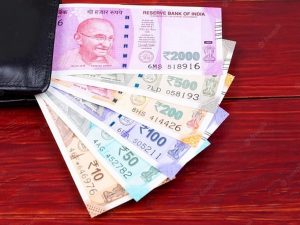
Fiscal deficit improved to 6.71% of the FY22 GDP over the revised budget estimate of 6.9% mainly on account of higher tax realisation.
- Unveiling the revenue-expenditure data of the Union government, the Controller General of Accounts (CGA) said that the fiscal deficit in absolute terms was ₹15,86,537 crore (provisional).
- Tax receipts during the fiscal were at ₹18.2 lakh crore as against the revised estimates (RE) of ₹17.65 lakh crore, the data showed.
- Total expenditure too was higher at ₹37.94 lakh crore against the RE of ₹37.7 lakh crore presented to Parliament on February 1, 2021.
- The CGA further said the revenue deficit at the end of the fiscal was 4.37% for fiscal year 2021-22.
- The fiscal deficit of the Centre was contained marginally below the FY22 revised estimate, benefitting from the higher tax and non-tax revenue receipts and lower capital spending, which absorbed the deficit in non-debt capital receipts and higher revenue expenditure.
ASTRA MK-I BVRAAM:

Ministry of Defence has signed a contract with Bharat Dynamics Limited (BDL) for supply of ASTRA MK-I Beyond Visual Range (BVR) Air to Air Missile (AAM) and associated equipment for the Indian Air Force & Indian Navy at a cost of Rs 2,971 crore under Buy (Indian-IDDM) category.
- Till now, the technology to manufacture missile of this class indigenously was not available.
- ASTRA MK-I BVR AAM has been Indigenously Designed & Developed by Defence Research and Development Organisation (DRDO) in coordination with the Indian Air Force (IAF).
- Air to Air missile with BVR capability provides large Stand Off Ranges to own fighter aircraft which can neutralise the adversary aircraft without exposing itself to adversary Air Defence measures, thereby gaining & sustaining superiority of the Air Space.
- This missile is technologically and economically superior to many such imported missile systems.
- The missile, for which successful trials have already been undertaken by the IAF, is fully integrated on the Su 30 MK-I fighter aircraft & will be integrated with other fighter aircraft in a phased manner, including the Light Combat Aircraft (Tejas).
- The Indian Navy will integrate the missile on the MiG 29K fighter aircraft.




